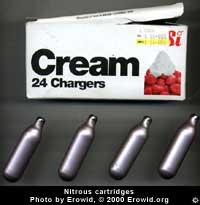Nitrous Oxide
Basics
DESCRIPTION #
Nitrous Oxide (N2O) is a simple gas that, when inhaled, causes rapid analgesia (pain relief), euphoria, mild sedation, and sometimes psychedelic dissociation. It has been used in dentistry since the mid 1800's and recreationally since the late 1700's when it earned the name 'laughing gas' because of its tendency to cause laughter in those who inhale.
Dose #
Nitrous is most frequently used in the form of whipped cream chargers, small metal cartridges which are 'cracked' either into a whipped cream canister or with a special 'cracker' into a balloon for inhalation. A single cartridge is between one and three lungs full of gas. One or two lung fulls is generally enough for a short nitrous experience although many people choose to use many cartridges throughout the course of a night.
Price #
nitrous chargers are sold for between .50 and 1.50 USD per cartridge depending on store and size of purchase. Balloons of nitrous at parties are sold from 3-5$ per balloon. Tank-refills of medical grade nitrous oxide are diverted from non recreational medical, chemical, and industrial use. A single standard whippet cartridge contains 8 grams of nitrous oxide.
Nitrous Oxide is unscheduled in the United States and available over the counter. In many states it is illegal to sell Nitrous to a minor and in some states it is specifically illegal to inhale Nitrous Oxide for intoxication purposes. Nitrous oxide is controlled differerently around the world. A few countries control it as a pharmaceutical, while many allow its possession for food uses without any licensing.
Nitrous Oxide (N2O) is an extremely simple naturally occurring gas which is produced synthetically for sale.
Pharmacology #
Pharmacology Summary Needed.
Production #
Production Summary Needed.
Nitrous Oxide gas was first discovered by English scientist Joseph Priestley in 1772 and was first published about in 1776. In 1799 Humphry Davy gave Nitrous to visitors at the Pneumatic Institute and coined the term "laughing gas". Through his experiments he discovered Nitrous oxide's analgesic effects in 1800. From 1800 to 1840, Nitrous was primarily used for recreation at travelling public shows, but in 1844-1845 Nitrous was recognized as having some medical use in dentistry. In the late 1800's William James published some accounts of his work with Nitrous Oxide and called its effects of "some metaphysical significance". Nitrous has remained popular throughout the 20th Century and is sold over the counter in small cartridges ("whippets") for making whipped cream and in large tanks for industrial and medical purposes.
Terminology / Slang #
The Substance:
Nitrous Oxide; Nitrous; Laughing Gas; Hippy Crack; N2O.
The Experience:
No common terms known.
Effects Summary Needed.
Onset #
When inhaled, Nitrous generally reaches full effects within a few seconds.
Duration #
Effects from a single inhalation of Nitrous Oxide last a few minutes. Most recreational Nitrous use consists of multiple inhalations over a period of time.
Visual Effects #
Some closed eye visuals effects are common with strong nitrous effects, though most often consist of patterns. Less common are more coherent visuals and are notoriously hard to remember after the effects have diminished. Open eye visuals are most often described as distortions of space and a purple or grey-blue hue.
Although generaly considered quite safe when used medically and sparingly, it has some negative health consequences when used chronically. Heavy Nitrous use can lead to a depletion of vitamin B12. This can cause numbing of fine nerve endings, especially noticeable in the fingers and toes. Supplements of B12 may reduce the chances of this occurring in heavy users. Shots of B12 are given as a treatment for advanced depletion. If left untreated B12 deficiency can lead to long-term damage.
Most of the acute dangers associated with Nitrous Oxide are related to accidents during ingestion. In medical applications, Nitrous is dispensed in combination with Oxygen. Inhaling Nitrous alone is not required to get full effects, the effects are the result of the nitrous in the system, not of oxygen deprivation. It is important for users to take breaths of air between hits.
A handful of people also suffocate each year while using nitrous in the US when the balloon, garbage bag, or mask used to inhale the nitrous stays on the person's face as they fade from consciousness. Some tank-users also suffocate when the valve is left open in a confined space such as a car or small room.
Most of the acute dangers associated with Nitrous Oxide are related to accidents during ingestion. In medical applications, Nitrous is dispensed in combination with Oxygen. Inhaling Nitrous alone is not required to get full effects, the effects are the result of the nitrous in the system, not of oxygen deprivation. It is important for users to take breaths of air between hits.
A handful of people also suffocate each year while using nitrous in the US when the balloon, garbage bag, or mask used to inhale the nitrous stays on the person's face as they fade from consciousness. Some tank-users also suffocate when the valve is left open in a confined space such as a car or small room.
Contraindications #
Contraindications Summary Needed.
Addiction Potential #
Nitrous has gained the nickname 'hippy-crack' because it lends itself to repeated and compulsive use for some people. While uncommon, it is not unheard of to find individuals who use Nitrous many times a day, every day, generally among those with easy access to large quantities.
Long Term Health Problems #
Long Term Health Problems Summary Needed.
Risk of Death #
Risk of Death Summary Needed.
CAUTION & DISCLAIMER #
Erowid Basics pages are summaries of data gathered from site visitors, government documents, books, websites, and other resources. We do our best to keep this information correct and up-to-date, but the field is complex and constantly changing. Information should always be verified through multiple sources.



